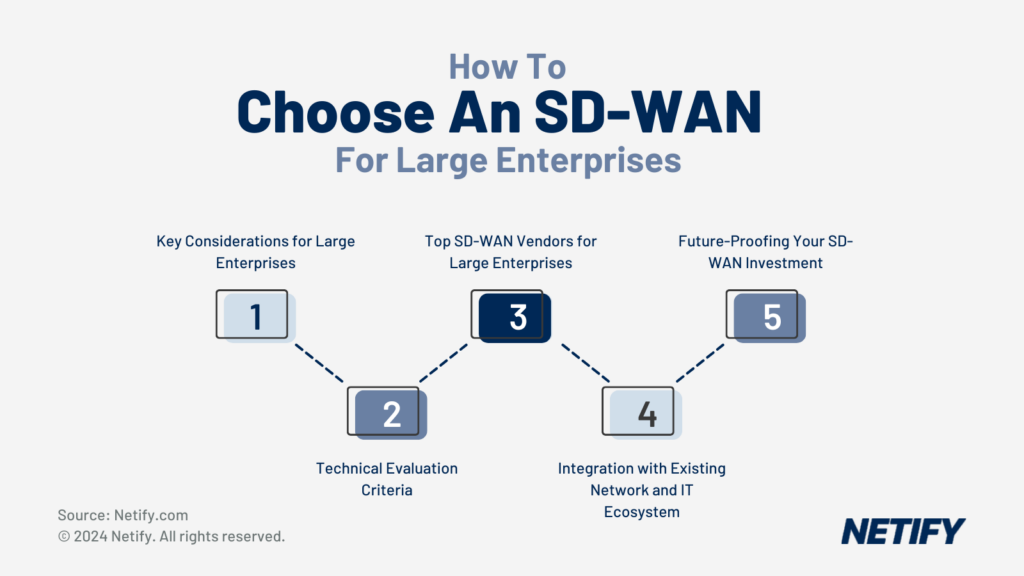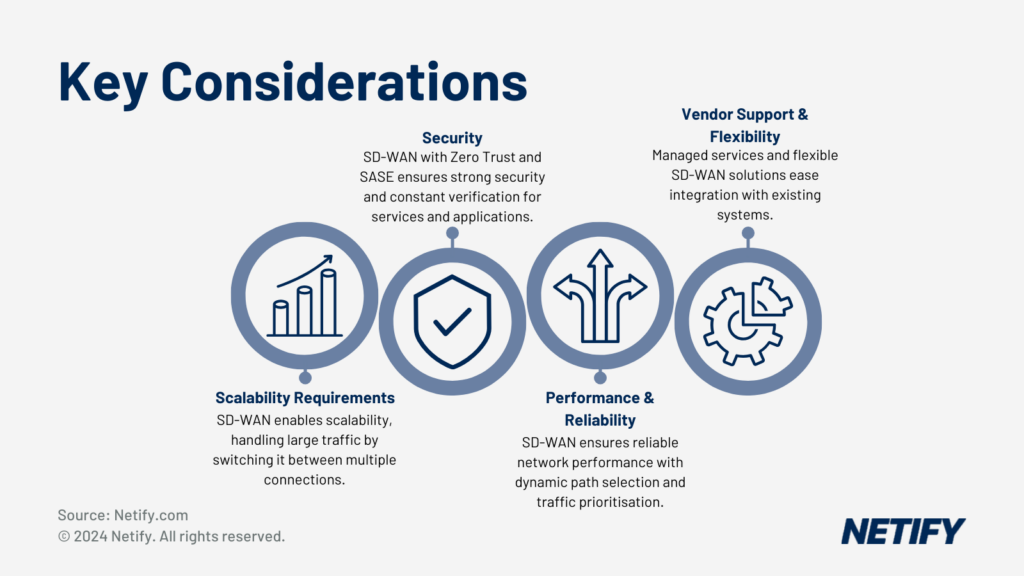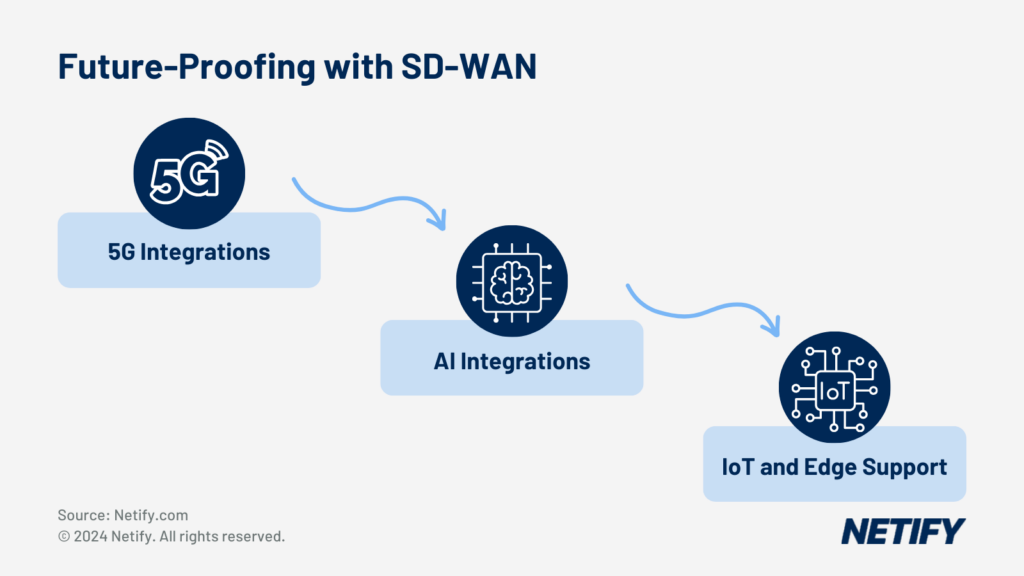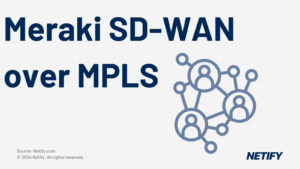| Choosing the right SD-WAN for large enterprises boosts network performance, scalability, and security while supporting global operations and remote work. |
For large enterprises, Software Defined Wide Area Network (SD-WAN) solutions offer a significant improvement to network performance, scalability and security when compared with traditional WAN networks. However, choosing the best SD-WAN solution can be a daunting task, especially given how many different features and requirements a global enterprise might have.

- How to choose an SD-WAN for Large Enterprises
- How to choose an SD-WAN for large enterprises.
In this article we explore the key considerations and features for large enterprises, including scalability, network performance, security features, and vendor support, to help businesses make an informed decision when choosing an SD-WAN solution.
Key Considerations for Large Enterprises
There are many key factors that large enterprises should consider when choosing an SD-WAN solution, with the weight that each factor bears being determined by their business operations, goals and network criteria.
Scalability Requirements
The first of these factors is the scalability requirements of the network. Global Enterprises can often have thousands of connected devices, both on-premises and remote. This adds a large volume of traffic that traditional WAN may struggle with and therefore enterprises need solutions that allow for this scalability, especially when considering dispersed environments.
SD-WAN provides the scalability that large enterprises require. It achieves this by allowing for switching between network connections in order to utilise multiple available links like broadband, 5G and MPLS.
Dynamic path selection automatically directs traffic via the best possible route, allowing for load balancing and continuation of daily operations in the event of link downtime. This is especially important for geographically dispersed sites where the available network links may be limited and therefore by utilising the best possible route at any given time, enterprises can maximise productivity and user experience (UX) through reductions in latency.

- Key Considerations for Large Enterprises when choosing an SD-WAN solution
- Key Considerations for Large Enterprises when choosing an SD-WAN solution
Network Performance and Reliability
For large enterprises, arguably network performance and the reliability of the network is the most important factor of all. With how intertwined network connectivity and business operations have become, ensuring that the network does not experience performance degradation or disruptions can be vital. Home workers and smaller offices utilise the capability for SD-WAN to make use of multiple connections which include Broadband, 4G and 5G.
Dynamic path selection helps to ensure the network remains scalable as circuits can be selected based on available bandwidth or even network latency and jitter. If the site is degraded or down, an alternative path will be used until the service is brought back up. A form of Quality of Service (QoS), Application Aware Routing can prioritise traffic such as video conferencing, Voice over Internet Protocol (VoIP) and Enterprise Resource Planning (ERP) solutions, in order to minimise latency and jitter for these applications.
Security Features
Given that large enterprises are often the target for malicious actors, enterprises will place security at the forefront of their network priority list.
One way that SD-WAN solutions have integrated security is through Zero Trust architecture implementations. Zero Trust means that no user, device or connection is inherently trusted by the network, requiring constant re-authentication and re-authorisation across the network to ensure that unauthorised access is continuously prevented. The Zero Trust approach is often associated with “Never Trust, Always Verify”, which in large enterprises provides constant security checks that can be applied across multiple access points and a diverse user base.
The combination of Secure Service Edge (SSE) and SD-WAN for Secure Access Service Edge (SASE) solutions has also created unified platforms for a focus on both performance and security in networks. SASE provides SD-WAN with security features such as Zero Trust Network Access (ZTNA), Secure Web Gateway (SWG), Firewall as a Service (FWaaS) and Cloud Access Security Broker (CASB). This unified approach for managing the SD-WAN network and the SASE security functionality ensures greater protection of the network and cloud resources for large enterprises, by allowing network administrators to align their entire network and its processes with Zero Trust principles.
Vendor Support and Flexibility
Given large enterprises are often distributed across time zones, monitoring and managing the network can be a difficult task. This difficulty is only amplified in environments where a single network administration team is responsible for managing all network edges. One way that enterprises can alleviate this issue is by leveraging managed services. Managed SD-WAN services can monitor and manage the network externally, reducing the workload demands for in-house network administration teams.
Another consideration is the flexibility of the SD-WAN solution. SD-WAN solutions aren’t necessarily built equally and this means that some solutions can integrate with enterprises’ other systems and security appliances more easily.
Technical Evaluation Criteria
Similarly to the key considerations, there are many technical factors that enterprises should consider in order to determine the best SD-WAN solution for their use case.
Deployment Models
Large enterprises often require a mix of deployment models, which is due to the diverse needs of different regions and environments, such as remote, hybrid and on-premises. By utilising a cloud-based deployment model, large enterprises can more easily scale and manage deployment of the network to new regions. This method allows enterprises to respond quicker to demands, as well as utilise ever-growing cloud-first strategies. Alternatively, by leveraging an on-premises deployment model, enterprises can ensure compliance with strict data sovereignty regulations.
Network Visibility and Control
Real-time visibility into network performance and security allows for large enterprises to effectively manage a complex distributed network, all abstracted into a simple management interface.
Total Cost of Ownership (TCO)
Organisations should note that the Total Cost of Ownership is not limited to just the initial investment in SD-WAN. There are many other costs which should be considered, such as the cost of licensing and underlying network connectivity. These factors can increase costs, making it important for organisations to budget for both the short and long term.
However, the enhanced connectivity of SD-WAN may alleviate reliance on more expensive connections, such as MPLS. This means that there can be cost benefits for organisations, which is also realised through features such as Zero Touch Provisioning (ZTP). ZTP enables organisations to deploy SD-WAN without on-site expertise, reducing staffing and operational costs.

- SD-WAN Technical Evaluation Criteria
- SD-WAN Technical Evaluation Criteria
Top SD-WAN Vendors for Large Enterprises
Cato offers a co-managed solution for simplifying network complexity, reducing costs and improving performance for globally distributed enterprises. For improved network performance, Cato offers a global private backbone with over 75 Points of Presence (PoPs) worldwide and this means that, for businesses looking for a simplified management system and perhaps don’t have a dedicated network management expert, Cato is an ideal contender.
Similarly to Cato, Aryaka also provides their own backbone. Aryaka is well known for their global connectivity which spans 40 worldwide PoPs together with the integration of SD-WAN and SASE network security for a combined managed service offering. Finally, we know Aryaka to be particularly strong in China – if your Enterprise is looking for managed services in the China region, Aryaka should make your shortlist.
Integration with Existing Network and IT Ecosystem
For large enterprises, integrating a new SD-WAN solution with existing infrastructure and IT systems can be complex and requires careful planning. It’s important that enterprises select an SD-WAN solution that can integrate with their pre-existing legacy, proprietary and security systems. In the event these aren’t compatible, organisations leave themselves open to needing significant investment back into the network to bring it up required standards.
Future-Proofing Your SD-WAN Investment
One of the factors to consider is that the SD-WAN solutions may offer 5G integrations, which for large, distributed enterprises with remote workforces, this offers network connectivity for workforces without dedicated broadband or MPLS connectivity. 5G can also be utilised as a fallback or redundancy connection, therefore adding more incentive for enterprises to consider 5G connectivity a future-proofing feature of SD-WAN.

- Future Proofing With SD-WAN
- Future Proofing With SD-WAN
Enterprises should also consider the implementations of Artificial Intelligence (AI) within SD-WAN solutions. AI and Machine Learning is commonly used in SD-WAN to analyse large data, such as real-time telemetry, historical routing and threat detection. Whilst AI can significantly improve network performance and security, the level of which it does so and its implementations vary from one solution to the next.
Typically Internet of Things (IoT) devices, such as sensors, generate vast quantities of data and this can flood the network, causing connections to become overwhelmed. This means that network links can experience latency or even have downtime. It’s therefore an important consideration for enterprises to look for Edge Computing and IoT support within the SD-WAN market. Edge Computing allows for processing of data at the network edge and therefore prevents raw data from flooding the network unnecessarily.
Conclusion
Large Enterprises will be well-aware of the limitations that traditional WAN provides and should look to SD-WAN for a more adaptable solution. SD-WAN can meet changing needs for performance, security and scalability, whilst new innovations such as AI and IoT are becoming increasingly supported.
However, it’s important that enterprises remember that SD-WAN solutions aren’t built equally. This means that enterprises should consider each vendor’s offerings, in order to ensure it meets business requirements.


